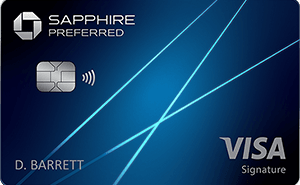Today there is no shortage of choices for credit cards, and understanding the many different types of credit cards out there can quickly become overwhelming.
Why? Because there are offers non-stop that will reach your inbox and mailbox. And you are definitely not alone in trying to make sense of what they all really mean – let alone which one you should choose.
But here’s what we know: if you use credit cards responsibly, they can be great financial tools to help you in life. You can use credit cards to earn rewards, cash back, free travel, and more. In addition to rewards, credit cards can offer temporary financing when you need it.
So today we’re breaking it down for you into the major general types of credit cards out there. Once you understand the types of credit cards available, it’s that much easier to figure out what you should choose for yourself.
What’s Ahead:
- Types of credit cards
- General rewards credit cards
- General travel credit cards
- Cash back credit cards
- Sign-up bonus offers credit cards
- Secured credit cards
- 0% Intro APR on purchases credit cards
- Balance transfers credit cards
- No annual fee credit cards
- Student credit cards
- Business credit cards
- Types of credit cards you’ll want to avoid
- Credit card types with special considerations
- Summary of recommended credit cards by type
Types of credit cards
There are several major categories of credit cards you can choose from. And, of course, some credit cards will fall into more than one category.
But understanding these categories is important because it helps you narrow your credit card search dramatically. A quick example: if you know you want a credit card with a low APR, you can focus your search on cards that offer that particular feature and ignore other cards.
General rewards credit cards
General rewards credit cards allow you to earn rewards that you can use for one of many redemption options. While the value of each redemption option may be different, you aren’t typically penalized for using your points for cash back as you may be with certain general travel credit cards. Instead, most redemption options offer similar values.
These cards can be great if you want the flexibility to redeem the points you earn for a number of different purposes including cash back, travel, merchandise, or gift cards.
General travel credit cards
If you aren’t loyal to a specific airline or hotel, general travel credit cards can be a great deal. Some of these cards allow you to redeem your rewards for travel at a higher redemption rate than other options, such as cash back or gift cards. Most of these cards offer bonus rewards for purchases on travel too.
While each general travel credit card works in different ways, these cards usually allow you to redeem your points for statement credits against travel purchases after the purchase posts on your credit card. That means you only have to purchase the airline ticket or pay for the hotel stay with your card. You don’t necessarily have to book the ticket or stay through a cumbersome travel portal.
Airline credit cards – if you end up traveling a lot on one airline, this will be an excellent option for you and here’s why. You’ll earn points or miles you can then redeem for free flights on that airline. Typically, you earn more points for flying with that airline, but you may be able to earn points on everyday purchases as well.
Hotel credit cards work a lot like airline credit cards. Each hotel chain may offer a credit card that allows you to earn points that you can redeem for free hotel stays. These cards may offer you automatic loyalty status with a brand, additional points for each dollar you spend at the chain, free upgrades if they’re available and even more perks.
If you don’t typically stick with just one hotel chain, a travel credit card that allows you to book free hotel nights at any hotel may be a better deal. These offer the most flexibility when you don’t have a hotel preference or loyalty status.
Recommended general travel credit card – Chase Sapphire Preferred® Card
The Chase Sapphire Preferred® Card allows you to earn 5X points on travel purchased through Chase Ultimate Rewards®, 3X points on dining, 2X points on all other travel purchases, and 1 point on all other purchases. While you can, of course, also redeem points for cash back, gift cards and merchandise, the real value comes from the travel redemption options. And hotels have gotten increasingly expensive.
You can transfer your points to select hotel and airline travel partner programs at one point to one point ratio. Alternatively, you can book travel through the Chase Ultimate Rewards® portal for a 25% value boost to your points. You can earn 80,000 bonus points after you spend $4,000 on purchases in the first 3 months from account opening. That's $1,000 when you redeem through Chase Ultimate Rewards®.
Read our full Chase Sapphire Preferred® Card review.
Cash back credit cards
Cash back credit cards are one of the easiest categories of credit cards to understand. While there are different types of cash back credit cards, they usually work in a straightforward way.
The simplest cash back cards offer a flat cash back rate on all purchases. More complicated cards offer varying levels of cash back in different spending categories like grocery stores and gas stations. Regardless, you usually earn cash back as a percentage of each purchase.
Once you have earned enough cash back, you can normally redeem the cash back for a check, statement credit or direct deposit depending on your particular cash back credit card. These cards are a great option for those who want a simple and straightforward way to earn credit card rewards.
Sign-up bonus offers credit cards
Some credit cards offer super attractive bonuses when you sign up including airline miles or cash back (the most common types) when you sign up. Yup, basically “free money” for you to spend as long as you spend a minimum required amount of money within the specified period of time after you open up the account. These cards often offer additional rewards for purchases made in certain categories.
For instance, a card may offer 5% cash back on up to $1,500 in purchases in categories that change each quarter. This prime example of a bonus category credit card allows you to earn even more cash back than you normally would be able to with a flat rate cash back credit card.
If you love maximizing your rewards and don’t mind juggling multiple credit cards, bonus category credit cards can help you get the most rewards for your spending.
Secured credit cards
Secured credit cards are typically best for people that don’t have credit at all, don’t have much credit, or have bad credit.
These credit cards allow you to put down a security deposit. The credit card company holds on to your security deposit and then, in most cases, issues you a credit card with a credit limit equal to or greater than your deposit.
The security deposit gives the credit card company a way to get their money if you default on your payments. They can simply take the security deposit to offset your balance owed.
Because of this, most people can qualify for a secured credit card whether they have bad credit or no credit at all. Once you prove yourself, your secured credit card may be upgraded to an unsecured card. In some cases, your credit may have improved enough for you to apply for and get approved for a regular unsecured credit card.
Recommended secured credit card – Discover it® Secured
The Discover it® Secured requires a refundable security deposit to open your account. Unlike many other secured credit cards, the Discover it® Secured card does not charge an annual fee.
In a rarity for secured cards, it even offers cash back on your purchases. You’ll receive your FICO score for free on your monthly statements which can help you monitor your credit health.
0% Intro APR on purchases credit cards
Instead of a regular low APR, some credit cards come with introductory offers that include a 0% APR on purchases for a particular time period. These offers can range from just a few months to as long as 20 months or more in some cases.
While it may be helpful to finance a large purchase with an introductory 0% APR on purchases credit card offer, you need to make sure you have a plan to pay it off in full before the introductory period expires.
If you don’t, be prepared to pay interest. After the introductory period expires, any balances remaining will be charged the regular APR which could be much higher than a low APR credit card.
Balance transfers credit cards
Another common introductory 0% APR offer involves balance transfers. These offers may allow you to pay no interest for up to 21 months or more on balances you transfer to the card. Some cards only apply this introductory 0% APR to balances transferred within the first couple of months after you open the card.
Using these offers to transfer debt, you’re trying to pay off can help you put more money toward paying off the debt each month since you won’t have to pay interest. That said, make sure to read the fine print to see if you’ll have to pay a balance transfer fee.
The fees typically range from three to five percent of the balance transferred. Finally, don’t forget that after the introductory 0% APR period expires, regular balance transfer APRs will apply for any remaining balance.
No annual fee credit cards
The no annual fee credit card category is extremely broad. It can include most of the other credit card categories as long as the card doesn’t have an annual fee.
No annual fee credit cards are great because they don’t have a cost you have to pay each year to keep the card active. This means you can keep the cards open and work to increase your length of credit history.
For that reason, it’s important that your first couple credit cards do not have annual fees as you normally don’t want to close your oldest lines of credit.
Recommended no annual fee credit card – Chase Freedom Flex℠
The Chase Freedom Flex℠ is a great no annual fee credit card that offers a bonus and regular cash back. The card also offers a 0% Intro APR on Purchases for 15 months and 0% Intro APR on Balance Transfers for 15 months (followed by the regular APR of 19.74% - 28.49% Variable).
You can earn 5% cash back on eligible purchases in rotating categories, 5% on travel purchased through Chase Ultimate Rewards®, 3% on dining and drugstores, and 1% on all other purchases. If that’s not enough, new cardholders will get a $200 bonus after you spend $500 on purchases in the first 3 months from account opening.
Read our full Chase Freedom Flex℠ review.
Student credit cards
Student credit cards are marketed directly to students as a way to start building credit. In general, you don’t need much of a credit history to get approved for these cards. However, you will need to have the ability to repay the card or get a co-signer to qualify.
These can be great for your first credit card. Just make sure they don’t charge an annual fee so you can keep the card for the long-term to help you build your credit.
Recommended student credit card – Discover it® Student Chrome
The Discover it® Student Chrome offers a $20 statement credit for each school year your GPA is 3.0 or higher for up to the next five years.
You’ll also earn 2% cash back at gas stations and restaurants on up to the first $1,000 in combined purchases each quarter and unlimited 1% cash back on all other purchases.
All cash back earned at the end of the first year is matched automatically and the card doesn’t charge an annual fee.
Business credit cards
Business credit cards are for businesses rather than individuals. These cards can offer rewards and promotional offers just like personal credit cards can. In fact, many of the above categories of credit cards would also apply to business credit cards.
Business credit cards are a must for any business that wants to keep their personal and business finances separate. Even if your business is structured as a sole proprietorship, you can apply for these cards with your Social Security number. Then, put all of your business purchases on your business cards and keep your personal purchases on your personal credit cards.
Types of credit cards you’ll want to avoid
While there are plenty of amazing credit cards out there, there are types of credit cards you may very well want to avoid.
As a general rule of thumb, you should avoid retail credit cards and subpar credit cards that I discuss in detail below. Note that there may occasionally be an exception to this rule. But more often than not, it’s better to skip them altogether.
Retail credit cards
Retail credit cards give companies a way to earn money by allowing consumers to finance their purchases with high-interest rates. They can also help people buy more at their favorite stores than they might be able to buy if they had to pay cash.
While these cards may offer no interest if you pay in full by a certain date, these cards can actually charge you interest from the date of the purchase if you violate the terms or don’t pay in full by the deadline. This is called deferred interest financing.
In addition, these cards typically offer poor rewards, if any at all, and normally have sky-high APRs outside of their promotional offers.
Subpar rewards cards
While there are a ton of rewards credit cards, most don’t offer the best earning rates or redemption options.
While the top cash back credit cards may offer two percent cash back on all purchases, there are plenty of cards that result in earning a value of one percent or less for every dollar you spend.
Always try to get a rewards value of at least one and a half percent, if not two percent or higher, for every dollar you spend on a rewards card.
Credit card types with special considerations
Finding the best credit card for you also depends on your particular situation and your credit.
For example, you may be looking to finance a large purchase for an extended period of time. Other potential reasons could include:
- Opening your first credit card to work toward building credit
- Transferring a balance to save on interest costs
- Finding a card with no foreign transaction fees for your upcoming overseas vacation
- Wanting to earn cash back on your purchases
- Working toward traveling for free with credit card rewards
- Opening a business credit card to keep personal and business expenses separate
So as you narrow down your choice for picking a new credit card, be sure to do a final review for how each credit card offer can actually help you meet your goal.
APR
In the case of financing a large purchase for an extended period of time, finding a card with a long introductory 0% APR offer will help you keep your interest costs down while you pay off your purchase.
While it’s important to look at how a credit card can help you meet your goals, you also need to make sure it isn’t going to cost you an arm and a leg to do so. That’s why it’s important to look at the APRs and fees for each credit card you’re considering, too.
In general, the lower the APRs and fees a credit card has, the better off you’ll be in the long-term if you ever have to carry a balance.
Other general benefits
Don’t forget to look at the other benefits credit cards offer, as well. Credit cards can save you a ton of money with features like price protection, extended warranty coverage, auto rental collision damage waiver, travel statement credits and more.
While these may not be the main reason you’re looking at a particular card, they can easily influence you to pick one card over another similar card that doesn’t offer additional benefits.
Summary of recommended credit cards by type
Now that you’ve got a top-down understanding of the different types of credit cards out there, it’s easier to understand why there are so many different types. Because it really depends on what you’re looking for and your particular situation, and what your priorities are for the given moment.
Our recommendations are summarized in the table below – our favorite cards in each category type; take a look!
| Card Type | Card |
|---|---|
| Secured credit cards | Discover it® Secured |
| Balance transfers credit cards | Discover it® Balance Transfer |
| General travel credit cards | Chase Sapphire Preferred® Card |
| No annual fee credit cards | Chase Freedom Flex℠ |
| Student credit cards | Discover it® Student Chrome |
There’s a lot to choose from out there for sure, and you may very well end up applying for more than one card!



